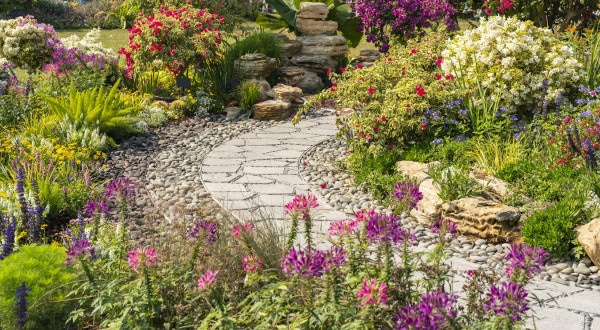Overwatering your plants is one of the biggest issues I see in landscapes today. When plants don’t look healthy it is tempting to give them more water and often this is a mistake, these are some of the few signs of overwatering plants. An overwatering mistake not easy to diagnose because in many instances overwatering mimics the signs of too little water.
Below are six signs you can easily recognize to determine if you are overwatering your plants or giving them too much water:
1) Your plant is wilting but it looks like it has plenty of water
The roots of plants take up water and also oxygen to survive and thrive. Overwatering your plants, in simple terms, drowns your plant. There is space between the particles of soil in your garden. Oxygen fills this space. Soil that is constantly wet won’t have enough air pockets and plants will not be able to breathe by taking up oxygen with their roots. When this occurs, your plants will wilt (giving the appearance of too little water) even though the soil is wet. Here is a great video from our friends at Denver Water about the negative side effects of too much water for your plants.
2) The tips of the leaves turn brown
One of the quickest, first signs of overwatering your plants is to observe occurs at the tip of the leaf. If the tip of the leaf is turning brown this is a sign of overwatering. Too little water will result in your plant’s leaves feeling dry and crispy to the touch while too much water results in soft and limp leaves.
3) Leaves turn brown and wilt
Leaves turn brown and wilt when plants have too little and too much water. The biggest difference is too little water will result in the leaves feeling crispy when you hold them in your hand. Too much water and the leaves will feel soft and limp in your hand.
4) EDMA
When roots of plants absorb more water than they can use, water pressure begins to build in the cells of the leaves. The cells will eventually burst, killing them and forming blisters and these areas will look like lesions. Once the blisters erupt, tan, brown or white warty growths begin to form where the blisters originally were. Plus you will see indentations forming directly above the growths on the top sides of the leaves.
5) Yellow leaves
Stunted slow growth with yellowing leaves is a symptom of overwatering your plants. Prevent this by checking up on your plants every few weeks.
6) Leaf fall
Leaf fall occurs in both situations of too much water and too little water. When both young and old leaves are falling prematurely combined with buds not opening, this is a sure sign of too much water.
How do you fix overwatering?
Check your soil regularly. Don’t be afraid to push you finger into the soil and see how moist it is an inch or two down. If the soil is moist and you have some of the conditions above it’s a sign to reduce your water. Also, many stores sell inexpensive and accurate moisture meters. You simply insert them in the root ball and they will tell you how much water is in the soil. This is a simple and inexpensive tool that will take much of the guesswork out of watering your landscape.
I hope these tips are helpful and please share a few of your own to avoid overwatering your plants in the comments area below. If you enjoyed this post please consider subscribing to the blog and follow me on twitter at H2OTrends.


will the yellow dropped leaves ever grow back?
With proper watering you will get much more leaf growth.
I cant be completely sure without a soil analysis. If your plants have plenty of water but they look wilted it is because osmosis in not occurring. The cation ratio is out of balance. You have a saturated soil condition. Due to sodium ion on the clay. Water must be moving through the soil profile for osmosis to occur. To solve the problem you need the pH to be slightly acid. Your EC must be above 2.0. Remember EC= Ca+Mg+Na in meq. Having a EC of 2.0 gives you a total of 20 meq. Mostly of the three cations Ca,Mg,and Na.They make up 95 % of the EC. Add a calcium source
( gypsum is the least expensive) to make your EC 65% soluble calcium. So you can leach out the sodium ion out of the soil profile and that will solve your soil problem(most likely). I cannot be sure without a soil analysis from AGRISERVE INC. 661-831-4868 ask for Michael L Carr
Michael, thanks for the information on soil health. I agree with you a soil analysis is especially helpful for any grower or gardener who is serious about plant health. You will know much more about how much to water if you know the make up of your soil and what nutrients if any it is lacking.
dang it i shuda read this before watering again
Thanks Joe. We also recommend using our new watersense epa certified controller: https://www.jainsusa.com/greeniq
can over watering cause my hanging plant from making flowers?
This is really awesome post. I like this topic and also I like the way you have written this post. This site has lots of advantage. I found so many interesting things from this site. It helps me in many ways. Thank you so much for sharing such an amazing post. Click this link to find out more information.https://lifewaterss.com/water-plant/
What can make my christmas cactus bloom?
Everything is waiting to bloom until Trump comes back, even cactus.